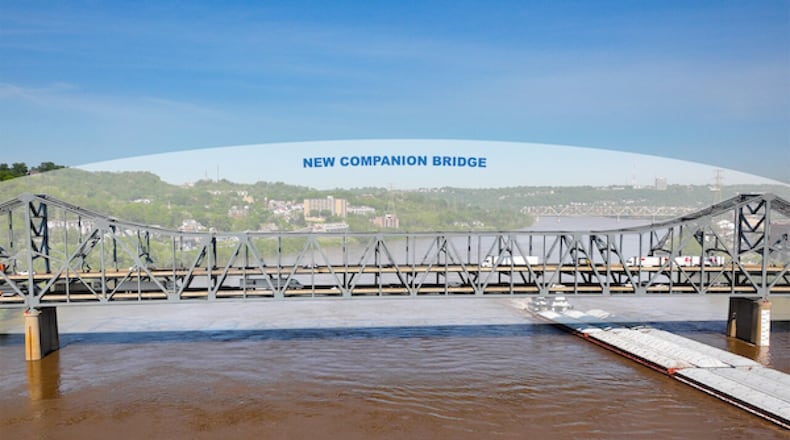New plans show the Brent Spence Bridge would be reduced to three lanes on both decks with wider emergency shoulders. The plans also indicate the Brent Spence Bridge would be only local traffic, with all thru highway traffic diverted to the new companion bridge.
The companion bridge’s footprint is greatly reduced from plans created in 2012, which would have given it four separate corridors, all with different destinations intended. Under that model, the companion bridge would have had 14-foot shoulders on either side. The 2012 model also would have had both highway and local traffic traveling both bridges, something the new model eliminates.
The 2022 model still successfully reduces congestion and improves safety for both bridges, but with the added result of having fewer property impacts overall, according to a press release from Beshear and DeWine.
“We felt good about where we were a decade ago because that solution provided additional capacity that reduces congestion and improves travel throughout the corridor,” said Jack Marchbanks, director of the Ohio Department of Transportation. “We feel even better about this revision because it dramatically reduces the footprint of the new bridge and completely separates interstate and local traffic.”
In February, DeWine and Beshear signed a memorandum of understanding seeking to secure federal funding from the infrastructure bill that would go toward fixing major traffic issues at the Brent Spence Bridge. They jointly submitted an application requesting nearly $2 billion in funding in May, but those funds have not yet been approved.
The governors announced in February the new companion bridge will be toll-free, which had been a point of debate for how a new bridge could be funded and operated.
In February, Marchbanks said if funding could be approved by the end of 2022 he believed a design procurement package could be ready by the fall of 2023. Marchbanks said then that a conservative estimation for completion of the project would be five years.
The possible reality of funding to solve the Brent Spence Bridge’s traffic debacles has been just out of reach for drivers in the Tri-State for years and time has become a crucial component. Opened 59 years ago, the bridge has long been considered functionally obsolete, carrying about 180,000 vehicles a day, which is more traffic than it was built to handle.
The bridge has officially needed a replacement since at least 1998, when the Federal Highway Administration determined it was no longer accommodating traffic needs.
DeWine himself declared that solving the Brent Spence problem would be a high priority after he was inaugurated as governor in 2019 while standing with then-Kentucky Gov. Matt Bevin.
Talks of replacing the bridge stalled with the arrival of the COVID-19 pandemic in 2020, however.
Later in 2020, those talks reignited once more after the bridge itself, well, ignited.
A fiery crash involving two semi tractor trailers set the bridge ablaze in a chemical fire that burned for hours and closed the Brent Spence Bridge for months.
Then came 2021, the bridge’s ranking as the nation’s second-worst traffic bottleneck, and the promise of an infrastructure bill. In January, President Joe Biden announced the creation of the Bridge Formula Program, which allocates $39 billion to states to fix bridges nationwide.
From that, Ohio is expected to receive $483.3 million over five years, with over $100 million of that set to be available this year. Kentucky would also receive $438 million total, with roughly $87.7 million available this year. That fund is different from grant funding available through the infrastructure bill, which means more dollars could be available to Ohio and Kentucky through grant applications.
WCPO is a content partner of Cox First Media.
About the Author
